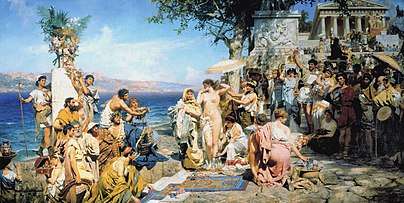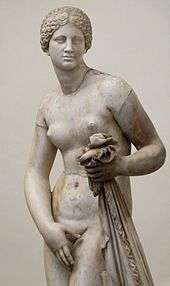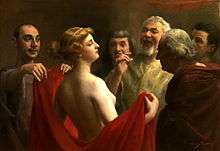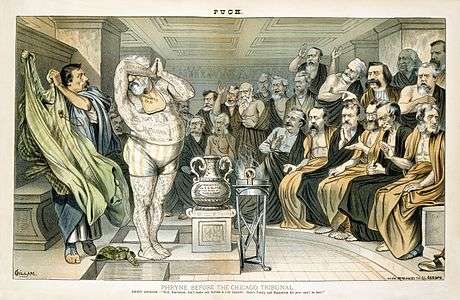Phryne
Phryne (/ˈfraɪni/; Ancient Greek: Φρύνη) (born c. 371 BC) was an ancient Greek courtesan (hetaira), from the fourth century BC. She is best known for her trial for impiety, where she was defended by the orator Hypereides.

Life

Phryne's real name was Mnesarete (Μνησαρέτη, "commemorating virtue"), but owing to her yellowish complexion she was called Phrýnē ("toad").[1] This was a nickname frequently given to other courtesans and prostitutes as well.[2] She was born as the daughter of Epicles at Thespiae in Boeotia, but lived in Athens.[3] The exact dates of her birth and death are unknown, but she was born about 371 BC. In that year Thebes razed Thespiae not long after the battle of Leuctra and expelled its inhabitants.[4] She might have outlived the reconstruction of Thebes in 315/316 BC.
Fame
Athenaeus provides many anecdotes about Phryne. He praises her beauty, writing that on the occasion of the festivals of the Eleusinia and Poseidonia she would let down her hair and step naked into the sea. This would have inspired the painter Apelles to create his famous picture of Aphrodite Anadyomene (Ἀφροδίτη Ἀναδυομένη, Rising from the Sea also portrayed at times as Venus Anadyomene). Supposedly the sculptor Praxiteles, who was also her lover, used her as the model for the statue of the Aphrodite of Knidos,[3] the first nude statue of a woman from ancient Greece.[5]
According to Athenaeus, Praxiteles produced two more statues for her, a statue of Eros which was consecrated in the temple of Thespiae and a statue of Phryne herself which was made of solid gold and consecrated in the temple of Delphi. It stood between the statues of Archidamus III and Philip II. When Crates of Thebes saw the statue he called it "a votive offering of the profligacy of Greece".[3] Pausanias reports that two statues of Apollo stood next to her statue and that it was made of gilded bronze.[6] Pausanias is almost certainly correct in his claim that gilded bronze was used.[7]
Athenaeus alleges she was so rich that she offered to fund the rebuilding of the walls of Thebes, which had been destroyed by Alexander the Great in 336 BC, on the condition that the words "Destroyed by Alexander, restored by Phryne the courtesan" be inscribed upon them.[3] Diogenes Laërtius narrates a failed attempt Phryne made on the virtue of the philosopher Xenocrates.[8]
Havelock argues that the story of Phryne swimming naked in the sea is probably a sensationalized fabrication.[2] Because Plutarch saw the statues in Thespiae and Delphi himself[1][9] Cavallini does not doubt their existence. She does think that the love between Praxiteles and Phryne was an invention of later biographers.[10] Thebes was restored in 315 or 316 BC,[11] but it is doubtful if Phryne ever proposed to rebuild its walls. Diodorus Siculus writes that the Athenians rebuilt the greater part of the wall and that Cassander provided more aid later. He makes no mention of Phryne's alleged offer.[12]
Trial
_-_01.jpg)

The best known event in Phryne's life is her trial. Athenaeus writes that she was prosecuted for a capital charge and defended by the orator Hypereides, who was one of her lovers.[3] Athenaeus does not specify the nature of the charge, but Pseudo-Plutarch writes that she was accused of impiety.[13] The speech for the prosecution was written by Anaximenes of Lampsacus according to Diodorus Periegetes. When it seemed as if the verdict would be unfavourable, Hypereides removed Phryne's robe and bared her breasts before the judges to arouse their pity. Her beauty instilled the judges with a superstitious fear, who could not bring themselves to condemn "a prophetess and priestess of Aphrodite" to death. They decided to acquit her out of pity.[3]
However, Athenaeus also provides a different account of the trial given in the Ephesia of Posidippus of Cassandreia. He simply describes Phryne as clasping the hand of each juror, pleading for her life with tears, without her disrobing being mentioned.[3] Craig Cooper argues that the account of Posidippus is the authentic version and that Phryne never bared her breasts before the court during her trial.[14]
According to Cooper, the first description of the trial given by Athenaeus and the shorter account of Pseudo-Plutarch ultimately derive from the work of the biographer Hermippus of Smyrna (c. 200 BC) who adapted the story from Idomeneus of Lampsacus (c. 300 BC). The account of Posidippus is the earliest known version. If the disrobing had happened, Posidippus would most likely have mentioned it because he was a comic poet. Therefore, it is likely that the disrobing of Phryne was a later invention, dating to some time after 290 BC, when Posidippus was active as a poet. Idomeneus was writing around that time.[14]
Furthermore, Cooper continues that the evidence suggests that Idomeneus invented the more salacious version of the story, possibly in his desire to parody and ridicule the courtroom displays of Athenian demagogues. Considering his preference for attributing sexual excess to these demagogues, the provocative act of disrobing Phryne fits the character Hypereides had acquired in Idomeneus' work. As is not uncommon in the biographical tradition, later biographers failed to notice that earlier biographers did not give an accurate representation of events. The later biographer Hermippus incorporated the account of Idomeneus in his own biography. An extract from Hermippus' biography is preserved in the work of Athenaeus and Pseudo-Plutarch.[14]
There are also arguments for the veracity of the disrobing. The words "a prophetess and priestess of Aphrodite" might have indicated that Phryne participated in the Aphrodisia festival on Aegina. If true, this would have showed the jurors that she was favored by the goddess and deserving of pity.[15] Also, it was accepted at the time that women were especially capable of evoking the sympathy of the judges. Mothers and children could be brought to courts for such purposes. The baring of breasts was not restricted or atypical for prostitutes or courtesans, and could be used to arouse compassion as well.[16]
In modern and contemporary culture

The trial of Phryne has inspired various works of art, including the painting Phryne before the Areopagus (Phryné devant l'Areopage) by Jean-Léon Gérôme, from 1861, although nothing in the sources indicates she was tried before that specific court;[17], the 1867 Phryne by Artur Grottger, the 1904 painting Phryne by José Frappa; the sculpture Phryné by French sculptor Alexandre Falguière; and the sculpture Phryne Before the Judges, by the American sculptor Albert Weine, from 1948. Other paintings inspired by Phryne's life include J. M. W. Turner's Phryne Going to the Public Baths as Venus – Demosthenes Taunted by Aeschines.
Other works of art inspired by the life of Phryne include Charles Baudelaire's poems Lesbos and La beauté and Rainer Maria Rilke's Die Flamingos; the opera Phryné by Camille Saint-Saëns; books by Dimitris Varos and Witold Jabłoński; and a 1953 film, Frine, cortigiana d'Oriente.[18]
References
- Plutarch, De Pythiae oraculis 14.
- Havelock, Christine Mitchell (2010). The Aphrodite of Knidos and Her Successors: A Historical Review of the Female Nude in Greek Art. Ann Arbor: The University of Michigan Press. p. 43. ISBN 978-0-472-03277-8.
- Athenaeus, Deipnosophistae 590–591.
- Stylianou, P. J. (1998). A Historical Commentary on Diodorus Siculus, Book 15. New York: Oxford University Press. p. 367. ISBN 978-0-19-815239-2.
- Dillon, Matthew (2002). Women and Girls in Classical Greek Religion. p. 195.
- Pausanias, Description of Greece 10.15.1
- Keesling, Catherine (2006). "Heavenly Bodies: Monuments to Prostitutes in Greek Sanctuaries". In Faraone, Christopher A.; McClure, Laura K. (eds.). Prostitutes and Courtesans in the Ancient World. Madison, Wisconsin: The University of Wisconsin Press. p. 67. ISBN 978-0-29-9213145.
- Diogenes Laërtius, Lives and Opinions of Eminent Philosophers 4.2
- Plutarch, Amatorius 9.
- Cavallini, Eleonora. "Phryne in Modern Art, Cinema and Cartoon". Retrieved 12 November 2012.
- "The Parian Marble". The Ashmolean Museum. Retrieved 12 November 2012.
- Diodorus Siculus, Bibliotheca historica 19.54.1–3, 19.63.4.
- Pseudo-Plutarch, Lives of the Ten Orators 9.
- Cooper, Craig (1995). "Hyperides and the trial of Phryne". Phoenix. 49 (4): 303–318. doi:10.2307/1088883. JSTOR 1088883.
- Nalden, F. S. (2006). Ancient Supplication. New York: Oxford University Press. p. 102. ISBN 978-0-19-538598-4.
- Havelock, Christine Mitchell (2010). The Aphrodite of Knidos and Her Successors: A Historical Review of the Female Nude in Greek Art. Ann Arbor: The University of Michigan Press. p. 45. ISBN 978-0-472-03277-8.
- Filonik, Jakub (2013). "Athenian impiety trials: a reappraisal". Dike (16): 63–66. doi:10.13130/1128-8221/4290. ISSN 1128-8221.
- Frine, cortigiana d'Oriente on IMDb
Further reading
- Aelianus, Claudius. "Book IX, 32". Varia Historia.
- Lardinois, André; McClure, Laura, eds. (2001). Making Silence Speak: Women's Voices in Greek Literature and Society. Princeton: Princeton University Press. ISBN 978-0-691-00466-2.
- McClure, Laura K. (2003). Courtesans at Table: Gender and Greek Literary Culture in Athenaeus. New York: Routledge. ISBN 978-0-415-93947-8.
- Morales, Helen (2011). "Fantasising Phryne: The psychology and ethics of ekphrasis". The Cambridge Classical Journal. 57 (1): 71–104. doi:10.1017/S1750270500001287.
- Pausanias. "Book I, 20". Description of Greece.
- Pausanias. "Book IX, 29". Description of Greece.
- Pliny the Elder. "Book XXXIV, 19". Naturalis Historia.
External links
